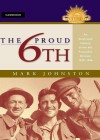The Proud 6th: An illustrated history of the 6th Australian Division, 1939-45
Written by: Mark Johnston,
Cambridge University Press, Port Melbourne, 2008,
ISBN: 9780521514118, 269pp.
Reviewed by: Phil Bradley
There is a wonderful tradition in Australia to write battalion histories and, as a result, very few divisional or brigade level histories have been written. This can make it very difficult to follow the history of Australian divisions in the two World Wars, particularly in the Second World War, where the divisions were often split up. With his third illustrated divisional history, Mark Johnston shows the value that such histories represent. The Proud 6th follows his earlier books on the Magnificent 9th and Silent 7th divisions.
The 6th was the first division raised for the second AIF and, for men brought up on the stories of the valour of the first AIF, the battle for Bardia, where the 16th and 17th Brigades were employed, confirmed that the latest crop was as good as the first. By achieving such a resounding victory in its first action of the war, the division set high expectations both for itself and for the rest of the second AIF for the entire war. With its spurs in place, two of the brigades went on to serve at Tobruk before the entire division was sent to Greece and, much of it, to Crete. As Johnston points out in a well-researched Appendix I, the 6th Division lost over 5000 men captured in Greece and Crete—almost as many men as the division had killed and wounded during the entire war. After a period in Syria and Ceylon, the division returned to Australia in August 1942 and the 16th Brigade was immediately sent to New Guinea to push the Japanese back along the Kokoda Trail to the coast. When the 17th Brigade followed, it flew into Wau to hold and then drive the Japanese back towards Salamaua. When the tide of the war in New Guinea needed to be turned, it was these two 6th Division brigades that did it. The division later went on to fight in the final Aitape-Wewak campaign.
Though Johnston is not a veteran, he has always reflected the veteran’s war experiences in his writing, and the same applies here. With the number of living veterans, particularly from the Middle-East campaigns getting fewer and fewer, Johnston has still managed to trawl up many of their diaries and photos to illuminate his book. Some of these gems have come from the families of veterans and perhaps this book will encourage more families to contact Mark. You will never see many of the photos he presents here anywhere else and certainly not the final one, which gives the reader the strongest indication of what it must have been like to have served with such men. Being so well illustrated and partitioned into caption related text, the book is very easy to read and reference. Though it is not intended to be a concise history, it is an excellent overview and, for most readers, that is an ideal balance. Those looking for more detail can go to the battalion and official histories as noted in the bibliography.
Johnston notes in Appendix II how difficult it was to receive decorations in the 6th Division; it was not until the final campaign in 1945 that Bert Chowne and Ted Kenna were awarded the Victoria Cross. In an interview with the official historian in July 1944, General Savige postulated that no VCs had been awarded within the division up to that time because ‘the exceptional leader did not stand out above the general level’. One wonders how much higher the recognition of the division would have been if men of the calibre of Bill Sherlock or ‘Bull’ Allen had been awarded the VCs they deserved. In this book Johnston recognises that Australia has much to be proud of with the 6th Division.

